by Eric Meier
In the world of wood, lignum vitae is the stuff of legends. The name is Latin for “wood of life,” which is derived from the tree’s many medicinal uses. Lignum vitae has been imported into Europe for medical use since 1508, and its use became so highly demanded that “the wood sold for as much as seven gold crowns a pound.”[1]Record, S. J., & Hess, R. W. (1949). Timbers of the new world (p. 556).Among commercially available hardwoods, it is widely regarded as the heaviest and hardest wood in the world (though when more obscure non-commercial woods are taken into account, there are a quite a few other contenders). It’s unique olive green color, delicate feathered grain pattern, and other-worldly rot resistance only serves to add to its aura.
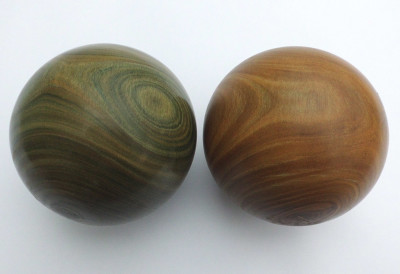
Given such a long and rich history, it should come as little surprise that genuine lignum vitae (Guaiacum officinale, G. sanctum) has has been exploited to the brink of extinction, and was among the inaugural round of endangered species from CITES (Convention on International Trade of Endangered Species) dating back to 1975.
As a result, a few closely related species outside of the Guaiacum genus—but still within the Zygophyllaceae family—have been substituted. Argentine lignum vitae (Plectrocarpa sarmientoi), and verawood (Plectrocarpa arborea) are two very closely related wood species, sometimes used interchangeably with one another. These two species have been used to satisfy some of the demand of genuine lignum vitae, yet in 2010, Argentine lignum vitae (Plectrocarpa sarmientoi ) was also added to the CITES Appendix II. Perhaps it’s only a matter of time before all variants and related species of lignum vitae are restricted from international trade.
So What’s the Problem?
To be fair, woods from both genera (Guaiacum and Plectrocarpa) are biologically classified in the same family: Zygophyllaceae. Both woods are extremely hard, heavy, oily, and have a distinct brownish olive color.
However, some retailers have adopted the dubious practice of dropping the “Argentine” or any other classifier from the common name and simply refer to Plectrocarpa species as lignum vitae. While Plectrocarpa is a satisfactory drop-in replacement for true lignum vitae for most applications (with the exception of bearings[2]Timbers of the World (p. 233). (1979). United Kingdom: Construction Press. TRADA.), this is a misleading omission that implies a historical wood of greater commercial value.
Telling Them Apart
Facegrain and Color
Facegrain and Color: Despite the subtle differences in grain and heartwood color shown in the samples above, all woods have a very similar color range, and could easily be confused with one another. In the broadest sense, genuine lignum vitae heartwood tends to have a slightly darker, more reddish cast, while the heartwood of Plectrocarpa tends to be slightly lighter in color and sometimes with a more olive cast. However, the color intensity and hue in all these species can shift over time, so relying on heartwood color alone, especially in aged pieces, should be considered insufficient on its own.
Average Dried Weight
Genuine lignum vitae
78.5 lbs/ft3 (1,260 kg/m3)
Argentine lignum vitae
74.9 lbs/ft3 (1,200 kg/m3)
Verawood
74.6 lbs/ft3 (1,195 kg/m3)
Average Dried Weight: Of the characteristics of identifying lignum vitae on this page, weight is probably the least reliable. On average, there is only 5% difference between the heaviest and lightest commercial species, which is well within the regular natural variation seen from tree to tree (and even from different parts within the trunk). When dealing with the dried weight of wood in general, it’s not at all out of place to expect to find pieces plus or minus ten percent from the given average weight.
Scent
Genuine Lignum Vitae
Lignum vitae has a mild, perfume-like fragrance, though its scent isn’t quite as pungent nor as lingering as the closely-related commercial woods in the Plectrocarpa genus.
Argentine Lignum Vitae and Verawood
Both these Plectrocarpa species have a distinct, perfume-like fragrance that lingers even after it has been machined. Argentine lignum vitae in particular is currently protected as an endangered species—in part due to its over-harvesting for extraction of its fragrant oil, sometimes called oil of guaiac.
Endgrain Anatomy
Endgrain Anatomy: Although the pores can be small and difficult to make out on all three species, examining the endgrain anatomy is really one of the easiest and most reliable ways to separate these woods. I suggest cleaning up the endgrain and possibly sanding it to a fine (400+) grit to help get a clear view of the pores and their arrangement. Using a 10x magnifying lens, you’ll notice a few things about the pores.
- Genuine lignum vitae’s pores are almost all exclusively solitary (that is, none of the pores are bunched together in groups or pairs).
- Genuine lignum vitae’s pores are arranged in a somewhat random pattern, or perhaps slightly diagonally.
- The pores of Argentine lignum vitae and verawood tend to be arranged in clusters and radial (vertical) rows. These grouped pore arrangements are a dead giveaway for Plectrocarpa spp.
- Despite the differences between the grain patterns of the two Plectrocarpa species pictured above, there tends to be a lot more variation in grain pattern with commercial Plectrocarpa species versus commercial Guaiacum species, and there isn’t an easy or reliable way to differentiate between the two Plectrocarpa species based on endgrain anatomy.
Are you an aspiring wood nerd?
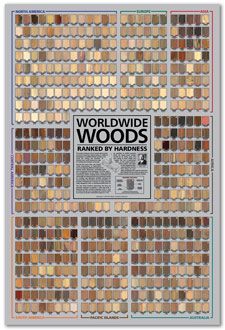


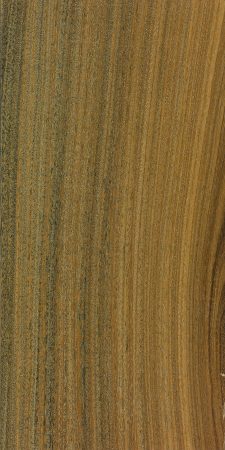



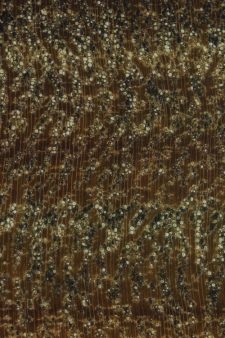
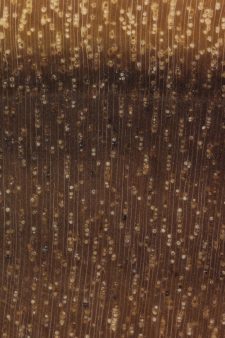



Cutting end grain of these very dense timbers is very difficult. My method will give you perfect results. Sand the end grain with progressively finer and finer abrasive papers. (Available from your motoring body shop). Then flood the end with acetone and place a piece of cellulose acetate film on it. (Overhead projector film will sort of work). Allow 15 seconds and strip the film off. It will remove most of the sanding dust. Repeat and repeat again. Your cross section will be perfect. Your final film stripped off will be a perfect replica of the surface. Gervais Sawyer
Hi Eric
Can you help me determine what kind of wood I have here? It’s been used for bulwarks and is at least 70 years old. It sinks in water. The magnification is 10x.
The fact that it sinks in water really narrows it down. It doesn’t appear to be lignum vitae. Maybe someone with more knowledge of bark might have a better idea. There’s a handful of South America species come a lot closer to matching this wood than others. Ipe would be a frontrunner (along with cumaru). Greenheart and goncalo alves are also possibilities.
Looks like greenheart. Chlorocardium rodiiae
Hey Eric.
I have a couple of pieces that I got in my possesion, though I am confused between lignum vitae and Holywood,
I will share a few pictures regarding to what I got (one of which is oiled in cooked linseed oil), but what is the diffrence between Lignum vitae from the caribbean, and Holywood?
and how comes that some pieces of lignum look more red than others?
Both genuine lignum vitae and holywood are from the Guaiacum genus, just two different species. I have samples of both, but I’ve yet to update my pages to show the two species. But I don’t know of a way to tell them apart. There’s a fair degree of color variation in the wood, possibly due to growing conditions, this is very common not just among lignum but with a lot of tropical hardwoods.
Is there any way we can have the different species listed as their own? Rather than having then all lumped under “lignum vitae”
It definitely is not an easy hardwood (genuine) to get. I have a quarter log I bough about 20 years ago from a woodworking buddy of mine. Made a couple sets of book ends, and still have about half the log left. But man, does it do a number on your tools.
Do you know a (brave/guitar builder) Luthier who has attempted to hand carve an acoustic Archtop guitar(backs & sides) with Argentine Lignum Vitae? I’ve used it for small carvings………but an entire Archtop guitar is another story. Am I lookin’ for BIG trouble? Is this a bad idea?? Pic’s?
those who are looking to secure the real thing should not neglect searching for vintage / antique items that were made of it: i.e., lead dressing tools for plumbers; old-time two-hole bowling balls, etc.
Hi. I wrote to you on another post a few days ago. A good example of questions that come up for me is what happened on today’s asia wood safari. Is this Argentine Mahogany? See pic below:….. can’t seem to attach photo.
Can you try again to upload pics?
Trying again now. Seems to work now. Maybe operator error before.
Whatever it is, it’s quite beautiful and should yield you some fine projects!
I see the picture, but I can’t tell too much from it. They appear to be very large slabs. I’m confused, you’ve posted this on the page about Argentine lignum vitae, but you’re asking if it is mahogany? Also, you got this wood at “asia wood safari”? Seems like it would be of Asian origin, no?
I was told it’s mahogany from Argentina and then found your article. I understand that Argentine lignum vitae is sometimes mistaken or sold as mahogany so I wondered if you could tell by looking at it. Asia wood safari refers to just searching for woods here. Sorry, I should have been more clear. Everything is imported. Names
of woods are changed or hidden. Origins are obscured. Quite frustrating.
I’ve never heard of mahogany getting mixed up with lignum vitae. Lignum vitae will sink in water and is very heavy.
Thanks.
hola, soy Luthier argentino, las tablas de tu foto, no son caoba argentina, esa madera aquí se le conoce como viraró. Es una madera muy dura, se usaba para pisos. Yo la he usado para mastiles de guitarra. Y mi abuelo carpintero la ha usado para construir heladeras de carnicero en los años 70s
Would lignum vitae possibly be turned to a size bowl as described here: https://rover.ebay.com/rover/0/0/0?mpre=https%3A%2F%2Fwww.ebay.com%2Fulk%2Fitm%2F293378681596
A wooden knife opener I made from Guaiacum officinale.
Two species of Lignum Vitae grow on the ABC Islands of the Dutch Caribbean: the Roughbark Lignum Vitae (Guaiacum officinale) and the Holywood Lignum Vitae (Guaiacum sanctum). While the trees were harvested on a large scale on Aruba, Bonaire and Curacao throughout the 18th and 19th centuries, they are now thriving on these islands and are a common sight. I have several Guaiacum officinale trees in my garden and I’m growing a hedge of them as well. I’ve also planted one Verawood, which indeed grows much faster.
I have some 2×12’s from an old old barn. It has a greenish heart. I routed on some, it really dulled my bit.
Id like to know if this is from south America. Maybe came from an old ship !
Lignum vitae isn’t generally processed into 2x12s. First test would be to fill a bucket with water and see if the wood sinks right to the bottom. If not, it’s probably something more ordinary. A picture of the endgrain would help with ID.
as eric says you won’t get lignum in that sort of section size. the wood you have may well be Greenheart.
Eric; thanks for the great article. I’ve grown many tropical hardwood species on my property in Central Florida and have to say that Verawood is one of my favorites. Much faster growing than Lignum Vitae and a nice ornamental with yellow flowers. I’ll post a photo of a tree I grew from seed. It was lost in a freeze and I used the wood to turn handles for the vices on my workbench.
This is an amazing compilation of data on woods of that world , very impressive and appreciated.A very big thank YOU!!
i have a piece of lignum vitae that is olive green but much lighter in colour than the lignum vitae photo on this site. It also has green lines in the grain. Do you think it is real?
I have a lamp that was given to us as a wedding gift in the ’70s. The bottom of it reads “Lignum Vitae Lamp Company, Designer David Kongas, Long Key Florida, 2 March 1978” It is a very large and heavy lamp. I am wondering how to determine its value as well as whether it is actually made of Lignum Vitae wood or not. I have attached a picture of the bottom of the lamp. Do you have any ideas?
We have a similar lamp with the same inscription. Did you have any luck researching the lamp/value?
I have a few pieces of argentine lignum vitae and it is the best wood I haave ever worked with hand tools. Dense and hard but not too much so and the aroma is wonderful. I used a piece for the handle of a hickory and bigleaf maple cane and the final result was spectacular.
I completely agree about the aroma. I have a trumpet turkey call turned out of it and it is my favorite because of the smell. Wish I could buy a candle that smelled like it.
Hi. I am looking for some Lignum Vitae to refurbish the outer propshaft bearings in a 1955 (small) warship. If anyone has any that they would be prepared to part with, I would appreciate a note. I am in Ireland btw. It is fair to say that, for my use, the Argentininian variety would suffice. I don’t have the money for fuel for any major voyages.
Get yourself some delrin, that would do the job best for a fraction of the cost.
There is an American company that make L.V. bearings … for water turbines/hydro-electric powerstations. It seems that nothing is anywhere near as good. My propshafts are 3 1/2″, in probably at least a 5″ housing.
Could genuine Lignum Vitae, be raise, on tree frams, as pine is raised in the southern states. If it could be raised in this way, what would be the best climite, for it to grow in the united states.
Lignum vitae is a relatively small and very slow growing tree, taking upwards of 15 years to reach the stage where one could cut lumber. In addition, the seeds display unpredictable germination periods and sprout extremely slowly. However, G. Officinale is grown as an ornamental tree in southern california and florida.
I guess it needs quite warm conditions to grow. I have discussed the possibility with someone else in Ireland.
G. Officinale does not like the cold. it grows best between 10° and 30° north latitude in moist warm climates. socal coast is really too dry for it and inland is too cold, but it will grow if it is taken care of.
One part of the country (Valentia Island) is considered sub-tropical due to the Gulf Stream. We are also seeing an increasing number of Tropical fish species such as Sunfish, Gt white sharks, Lions Mane jellies and Portugese Man-o-war. No Box jellies or Irukandjis (yet).
By the way, I love your explanation of the difference between Genuine Lignum Vitae and Bulnesia.
Dear Robert, if the Lignum Vitae piece you have is from the Dominican Republic it is most probably Ganuine as Bulnesia or Argentine Lignum Vitae grows further South in Bolivia, Argentina, Paraguay among other Countries.
Good morning, I have an old wood piece from the Doinican Republic.
I believe the wood type is Lignum Vitae. I was hoping that you could identify the wood by a picture. Thank you for any help you might provide. Regards, Robert